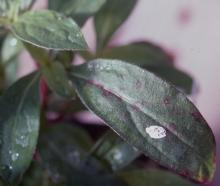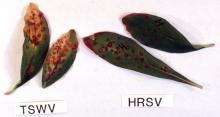See:
Greenhouse Plants, Ornamental - Impatiens Necrotic Spot
Cause There are 14 viruses reported for hydrangea. Hydrangea ringspot virus (HRSV) can be transmitted mechanically by leaf contact or by knives but not through seed or by aphids. Suspected as cause of hydrangea running-out. Many cultivars are tolerant of the virus.
Hydrangea chlorotic mottle virus (HdCMV) can be transmitted mechanically or by the green peach aphid (Myzus persicae) but only infects H. macrophylla.
Tomato ringspot virus (ToRSV) and tobacco ringspot virus (TRSV) are primarily vectored by nematodes. Cherry leaf roll virus has also been reported on hydrangea. Tomato spotted wilt virus (TSWV) has also been recovered from hydrangea and is vectored by the western flower thrips.
Symptoms HRSV - Leaves may show chlorotic to brown leaf spots or rings. Leaves become crinkled, rolled, and asymmetric. The number of florets per inflorescence also is lower in infected plants. Severe stunting and running-out also may occur.
HdCMV - Leaf mottling, blistering, and reddening and chlorotic ring spots were among the various symptoms found. Symptoms in the cultivar Endless Summer were more frequent during the spring but less so during the summer.
TRSV - stunting, some leaf distortion and leaf chlorosis with green blotches on leaves. Flower virescence (turning green) can also occur.
TSWV - Ringspots are common but indistinguishable from those caused by HdRSV.
Cultural control
- Soak knives in trisodium phosphate or other disinfestants often when taking cuttings. Use two knives so a worker can cut with one while the other soaks. When done with a batch, cultivar, etc. switch one knife for the other and allow the used one to soak.
- Buy clean stock, or isolate new stock from main plantings.
- Avoid nematode-vectored viruses by planting clean stock in containers in soilless media.
- Control weeds that may be reservoirs of virus and insect vectors.
References Machado Caballero, J. E., Lockhart, B. E., Mason, S. L., and Daughtrey, M. 2009. Identification and properties of a carlavirus causing chlorotic mottle of florists' hydrangea (H. macrophylla) in the United States. Plant Disease 93:891-895.
Williams-Woodward, J.L. and Daughtrey, M.L. Hydrangea diseases. In: Jones, R.K. and Benson, D.M. (eds.) 2001. Diseases of Woody Ornamentals and Trees in Nurseries. St. Paul, MN: APS Press.



